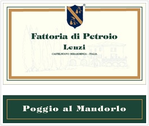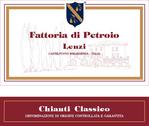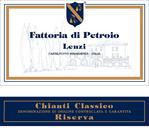
| Fattoria Petroio lies in the heart of Chianti Classico, midway between Castellina and Siena in the hamlet of Quercegrossa. They are neighbors of the Fonterutoli estate (to whom they sold 15 HA of vine-plantable land 10 years ago).
The history of the settlement of Petroio goes back to the times of the ancient Romans as may still be seen in the ancient “opus reticulatum” wall incorporated into a farm house near the main cellar. The paved road that passes right in front of the main villa is a remnant of the ancient medieval road connecting Siena and Florence, which passed through the Chianti territory. It leads toward a small church dating back to the early 11th century and dedicated to St. Michael the Archangel. The Lenzi family currently leases the chapel from the Curia in Siena and recently completed its restoration. Once a year, on Ascension Day, a Mass is said that is open to all the people from the village, followed by a ‘Fiesta’ with buffet (which the owners prepare and serve) and traditional music and dancing on the old threshing floor in front of the wine cellars. The name Petroio comes from “Pietra” which means “stone”. All the buildings were made from local stone and traditionally white washed every 2 to 3 years. In recent years they have been restored to show the stones and the wood beamed ceilings. The Petroio Estate has been in the Pallini family since circa 1886. The entire property was originally over 160 hectares of fields woods, vineyards and olive groves. The estate now occupies 100 hectares. The Lenzi family started restoring the estate in 1980 with the help of the now renowned consulting oenologist Carlo Ferrini, (WS Winemaker of the Year), who at that time was working for the Consorzio del Chianti Classico, and as an inspector gave free advice to members. He remained with the Lenzis to this day, even after leaving the Consorzio. The old family estate had 5000 white vines so in 1983 Carlo had them hand-grafted to Sangiovese and Colorino vines; only four vines did not take! The Lenzi’s have always had great pride in their clones of the indigenous grape, Sangiovese, and have continued to resist planting international varietals.
Vineyards: Petroio has been reducing yields and overall quantity in order to improve the quality of the finished wines. Each variety is harvested separately. Newer clones of Sangiovese with thinner skin are used. 2015 was the first fully organic vintage. Winemaking: the grapes are all handpicked, put in small plastic bins, delivered onto the sorting table and after the final hand selection, into the crusher. They used to truck the grapes "en masse", with no plastic bins, but since 2007 Petroio practices gentler harvesting and crushing. Grape varietals are harvested and vinified separately in glass lined cement tanks. Experimentation with indigenous yeasts has been quite successful and the aim is to move towards 100% indigenous yeasts in the future. The wines are vegan. Pumping over is done for 8 to 10 days, three times a day, depending on the vintage. All pressed wine is sold in bulk. The barrels (500 liter Allier noisette barrels from Sylvain and Nadalie) are all seasoned with hot water before they are used for wine. In the spring following the harvest, Ilaria Marcomini and Alessio Petrucci, together with the owners and Carlo, select which wine will go in the Normale and which will be blended and set aside to age as the Riserva. “Petroio is not just vineyards, vines, olive groves, wine and olive oil. Petroio is also 247 acres of woodlands dedicated to the repopulation and preservation of the local fauna. Petroio is not, therefore, just the Lenzi family Villa at the end of the cypress drive but innumerable deers, foxes, porcupines, wild boars, hares, pheasants and many other local bird varieties that, among the tall trees and shrub, find refuge from the nearby expanding town, the cars speeding by on the once gravel road, and the local hunters now radio connected during their hunting." |
| Fattoria di Petroio Website |
 |
| Poggio al Mandorlo - IGT Toscana |
| 100% Sangiovese from new vines. Aged in cement tanks with glass lining. A fresh, young, bright ruby red wine. The nose is fruity with light mineral notes. In the mouth a fresh start shows simply and pleasantly the inherent characteristics of Sangiovese. The crisp acidity leaves the mouth clean and fresh. Enjoy with light, rustic dishes. 13.5% Alcohol. 387 cases produced. |
 |
| Chianti Classico |
| 90% Sangiovese, 10% Colorino & Malvasia Nera. 80% of the wine is aged for 14 months in tonneaux (500 liters) and the remaining 20% is left in cement for 14 months. Very light filtration is practiced before bottling. On the nose, deep fruity notes of pear and cooked prunes, turning into more spicy tones. On the palate, full and yet clean and dry with taste of ripe cherries and plums. 1766 cases produced. |
 |
| Chianti Classico Reserva |
| 100% Sangiovese. The wine is aged for 20 months in 5hl tonneaux of new French oak, then 12 months in 25hl French oak, Italian made barrels. The Riserva wine is bottle aged for at least 6 months before it is released. 5,300 bottles produced. |
| Copyright © 2002-2017 VOS Selections, Inc. |